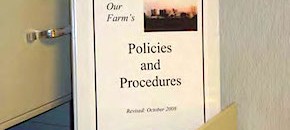The recent extended period of cloudy weather and high soil moisture may have resulted in certain crops growing rapidly and developing a thinner than “normal” wax layer, called the cuticle, on the leaves. This thinner cuticle is more easily penetrated by postemergence herbicides. Warm temperatures during the cloudy moist period will increase the speed of […]
Continue reading...Weather Increases the Risk of Crop Injury from Herbicides Applied Postemergence
Audit Ready:
On-Farm Food Safety Lessons Learned Series

If you have written your food safety plan and are preparing for a third party audit, the Rutgers On-Farm Food Safety Team offers farm “walk-throughs” to help evaluate your written plan and compliance activities. Over many years of performing walk-throughs, we’ve found some common situations that can foil the goal of making it through the […]
Continue reading...Fruit IPM Report June 11, 2014
This week in Fruit IPM Peach Apple Pear Wine Grapes Scouting Calendar Tree Fruit Trap Counts Blueberry Blueberry Trap Counts Click to View | Download PDF
Continue reading...Potato Disease Forecasting Report 6-13-14
Potato Disease Forecasting Report 6-13-14 – Click to Download We will be tracking DSVs for Late blight development and calculating P-days for initiating the first early blight fungicide application. The first late blight fungicide application is recommended once 18 DSVs accumulate from green row. Green row typically occurs around the first week in May in southern […]
Continue reading...Tomato Disease Forecasting Report 6-13-14
6-13-14 Tomato Report – Click to Download Disease severity values (DSVs) for early blight, septoria leaf spot, and tomato anthracnose development are determined daily based on leaf wetness (due to rainfall, dew) and air temperature. On a daily basis DSV values can range from 0 to 4 where 0 = no chance for disease development […]
Continue reading...Bacterial Spot of Stone Fruit
Over the past 7-10 days it has become clear that a bacterial spot epidemic is underway. It is eerily reminiscent of the epidemic of 1997, although so far it does not appear as widespread or affecting all cultivars as that year. Many blocks are dropping leaves this week, and fruit lesions are beginning to appear. […]
Continue reading...